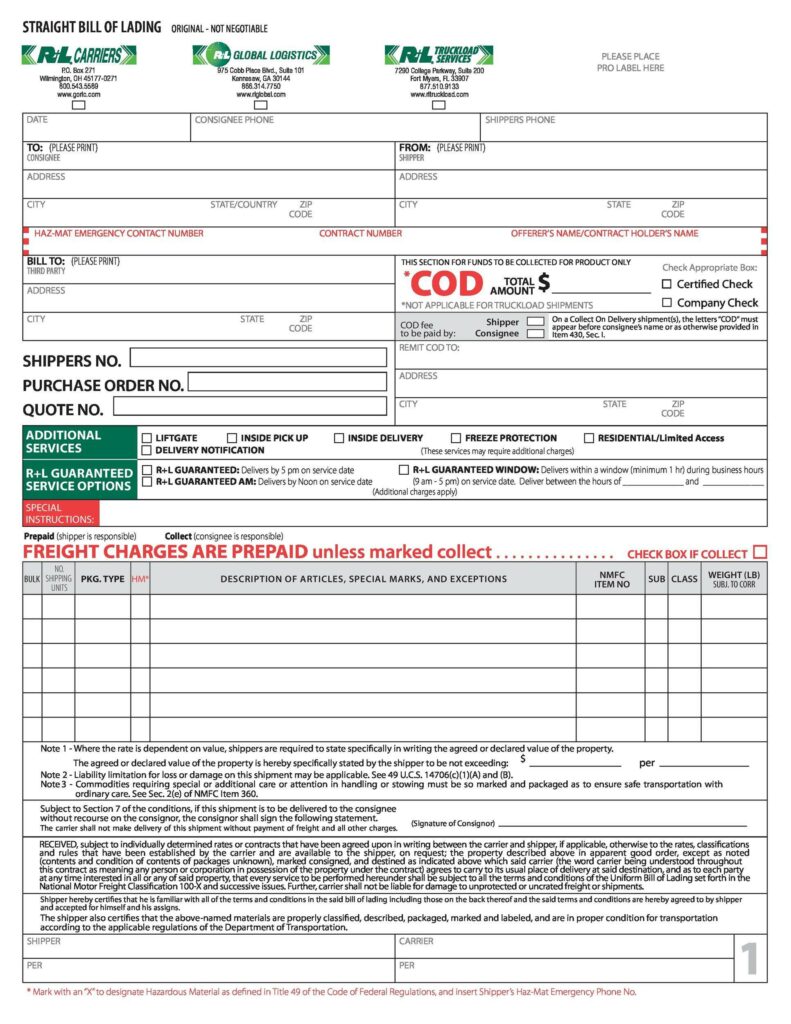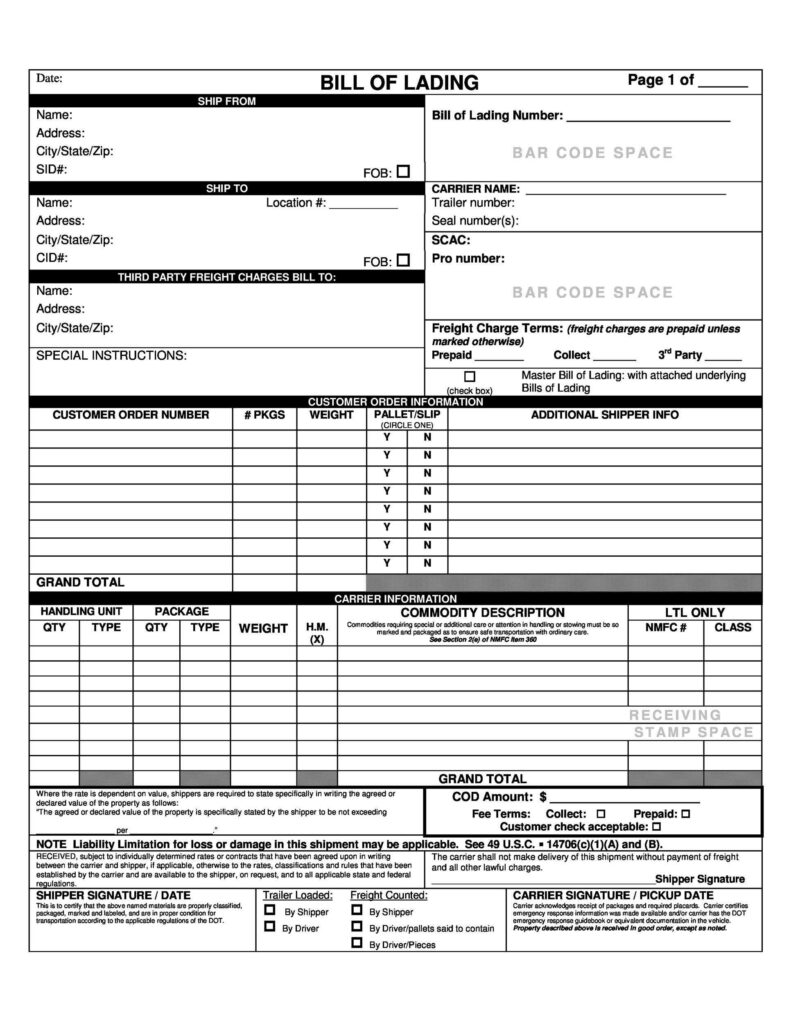In the bustling world of logistics and shipping, the Bill Of Lading Sample Form stands as a crucial document, often likened to the North Star guiding vessels through tumultuous waters. Whether you’re a seasoned merchant or a budding entrepreneur venturing into the realm of international trade, grasping the significance of this document is paramount. Join us as we embark on a journey to demystify the intricacies of the Bill Of Lading Sample Form, empowering you to navigate the seas of shipping with confidence.
Unlocking the Mysteries of the Bill Of Lading Sample Form
What is a Bill Of Lading?
At its core, a Bill Of Lading serves as a receipt of goods, a document of title, and a contract of carriage between the shipper and the carrier. It embodies the essence of the transaction, detailing essential information about the cargo being transported, the parties involved, and the terms of shipment.
The Components of a Bill Of Lading Sample Form
- Shipper Information: This section delineates details about the entity dispatching the goods, including their name, address, and contact information.
- Consignee Details: Here, you’ll find information regarding the recipient of the shipment, encompassing their name, address, and pertinent contact details.
- Description of Goods: A meticulous description of the goods being transported, including their quantity, weight, dimensions, and any distinguishing characteristics.
- Shipping Terms: This segment elucidates the terms of shipment, encompassing crucial information such as the mode of transportation, delivery instructions, and any special handling requirements.
- Freight Charges: An itemized breakdown of the charges associated with the shipment, including freight costs, insurance premiums, and any additional fees.
- Carrier’s Liability Clause: This clause outlines the extent of the carrier’s liability in the event of loss, damage, or delay to the cargo during transit.
- Signatures and Date: Signatures from both the shipper and the carrier authenticate the document, affirming their agreement to the terms outlined therein.

Why is the Bill Of Lading Sample Form Important?
- Legal Protection: By meticulously documenting the terms of shipment, the Bill Of Lading serves as a legal shield, safeguarding the interests of both the shipper and the carrier.
- Title of Goods: It establishes ownership of the goods in transit, facilitating seamless transfer of ownership from the shipper to the consignee upon delivery.
- Documentation for Customs Clearance: Customs authorities rely on the Bill Of Lading to verify the contents of the shipment and assess applicable duties and taxes.
- Proof of Delivery: In the event of disputes or discrepancies, the Bill Of Lading serves as irrefutable evidence of the shipment’s condition at the time of receipt.
Filling Out the Bill Of Lading Sample Form
- Accuracy is Key: Ensure all information provided is accurate and up-to-date to prevent delays or complications during transit.
- Clarity and Precision: Use clear, concise language when describing the goods and their specifications to avoid any ambiguity.
- Attention to Detail: Double-check all entries for accuracy, including addresses, contact information, and freight charges.
- Legal Consultation: When in doubt, seek legal counsel to ensure compliance with international shipping regulations and mitigate potential liabilities.
Exploring Common Questions About Bill Of Lading Sample Forms
1. Can I Use a Generic Bill Of Lading Template?
While generic templates can provide a basic framework, it’s crucial to tailor the Bill Of Lading to your specific shipment and contractual arrangements. Customizing the document ensures that all pertinent details are accurately captured, reducing the risk of misunderstandings or disputes.
2. What If There Are Changes to the Shipment After the Bill Of Lading is Issued?
If modifications to the shipment occur post-issuance of the Bill Of Lading, it’s imperative to update the document accordingly. This may involve issuing an amended Bill Of Lading or attaching addendums to reflect the revised terms accurately. Prompt communication between the shipper and the carrier is essential to facilitate smooth transitions and maintain compliance with contractual obligations.
3. Are Electronic Bill Of Lading (eBOL) Valid Alternatives?
With advancements in technology, electronic Bill Of Lading (eBOL) solutions have emerged as viable alternatives to traditional paper-based documentation. eBOLs offer numerous benefits, including enhanced efficiency, reduced paperwork, and improved traceability. However, it’s essential to ensure that eBOL systems comply with regulatory requirements and provide robust security measures to safeguard sensitive information.
4. What Role Does the Bill Of Lading Play in Freight Payment and Audit Processes?
The Bill Of Lading serves as a foundational document in freight payment and audit processes, providing a detailed record of the shipment’s terms and conditions. It serves as a reference point for verifying the accuracy of freight invoices and reconciling discrepancies that may arise during the payment cycle. By aligning the Bill Of Lading with other relevant documentation, such as packing lists and invoices, organizations can streamline their financial workflows and enhance transparency in their supply chain operations.
5. How Should I Handle Lost or Damaged Bill Of Lading Documents?
In the unfortunate event of lost or damaged Bill Of Lading documents, swift action is imperative to mitigate potential disruptions to the shipment. It’s advisable to notify all relevant parties, including the carrier and the consignee, and initiate the necessary steps to reconstruct or reissue the documentation. Additionally, maintaining comprehensive records and implementing robust document management practices can help prevent such incidents and facilitate timely resolution in the event of unforeseen challenges.

In Conclusion
The Bill Of Lading Sample Form embodies the essence of trust and transparency in the realm of global trade, serving as a testament to the symbiotic relationship between shippers and carriers. By embracing its significance and adhering to best practices in documentation, you can navigate the complexities of international shipping with confidence and integrity.
As you embark on your shipping endeavors, remember that the Bill Of Lading is more than just a piece of paper—it’s a binding contract, a symbol of accountability, and a beacon of reliability in an ever-evolving landscape. With diligence, attention to detail, and a commitment to excellence, you can harness the power of the Bill Of Lading to propel your business towards new horizons of success.
Smooth seas and fair winds await—bon voyage!
